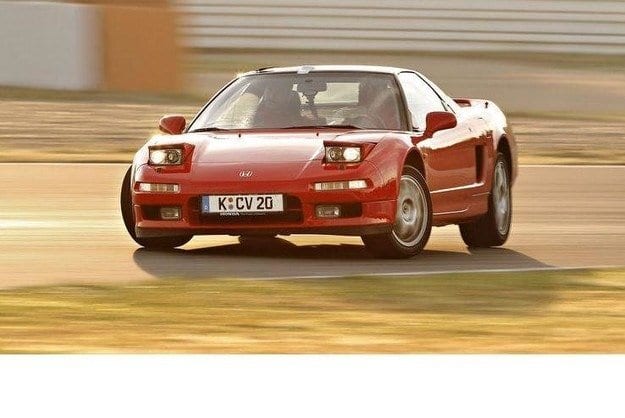
Test drive Honda NSX: Faster than its shadow

A test of a great but underrated sports car, likely a future in-demand classic.
Is there a more underrated car than the Honda NSX? It may be difficult for us to find. In our Veteran Challenge series, the Japanese model leaves behind shadows of the past. Hockenheim, alcohol, drugs and her purpose will be present in this drama.
As the morning gradually takes the power of the night, the NSX leaves the darkness behind and catches up with its long shadows on its way west. So many sunrises, so many new days, in the first rays of which no one knows how many memories they will leave. Memory is like a path through the jungle of our thoughts. I think if we don't clean it up to get to it, it will grow over time. Then the speed limit ends, the engine speed rises to 7300, and the pistons and titanium drums race at an average speed of 19 m/s on the way from top to bottom and back. And as the sun creeps over the horizon and its reflection leaves the rearview mirror, another memory pops up in my mind-exactly 9204 days ago, quite banal but important because it completes the cycle.
Photo from Auto Motor und Sport 17 issue 1993 in an article about the Hockenheimring Grand Prix. You can see three cars on it. In front of the Ernst-Wilhelm-Sachs-Haus, two S-classes stopped: one was Bernie Ecclestone, the other was Max Mosley. The Honda NSX of world champion Ayrton Senna is parked nearby. No one knows why some things are remembered and others are not, and what is the logic of the flow of associations. The Declaration of Independence of Abkhazia, the aviation agreement between the Dominican Republic and Germany of July 23, 1992, or Kazakhstan's accession to the World Bank on July 24? Long forgotten facts - but not where Senna and his NSX were on July 25th. Where exactly is our heading now.
Before we get there, the NSX drifts down the A6 motorway, the air whirls quietly around the front fender lights and slides to the domed roof and from there to the rear fender, thus creating a pressure of 134 newtons at 200 km / h. Even this early morning there are many cars going on the highway, much faster than this Honda NSX. This comes from a time when high-powered cars did not rely on turbocharging and were not widely available, but were only intended for those who could handle them.
Streets of Memories
Waldorf clover, motorway A5, a little north, then on the L723 - and Hockenheim appears on the right. At the entrance is our famous petrol station. We caused a stir here a few weeks ago with a Porsche 959. This is not happening today – the NSX does not arouse the curiosity of those present, does not become the focus of smartphone cameras, and even the car wash, which seemed to worship the 959 with its ritual movements, washes the dust off the NSX with indifference with which the Civic would be washed.
What a misunderstanding! Because the NSX is one of the most impressive sports cars of its time - and its time span is long, over a decade and a half. Honda introduced the model at the 1989 Chicago Auto Show as a competitor to the Ferrari 328. This sounds immodest and overly ambitious, given the fact that the Japanese company only started making cars in 1963, when Ferrari had already won six Formula One championships. However, the request is not a mere presumption because Honda is throwing huge financial and engineering resources into building the car. As a result, the NSX acquires high-tech solutions, such as aluminum panels and chassis, which are attached to a semi-monocoque body. The independent suspension with two filigree triangular elements on the wheel was described by the designer of the Formula 1 luminary Gordon Murray as a "masterpiece". Especially for the NSX, Honda is developing a traction control system and electric power steering, which is presented for the first time in an automatic transmission version.
As for the power plant, engineers are experimenting with various solutions, such as V8 and V6 biturbo engines. However, since the NSX is designed to be comfortable to drive every day, they opt for the naturally aspirated 2,7-liter V6 Legend - largely for its reliability and low maintenance (whereas the Ferrari 328 engine requires a timing belt change in three years or 20 000 km, while Honda has parameters of 8 years and 100 km, respectively). On the other hand, the car delivers "enough power," as Honda head of development Nobuhiko Kawamoto put it. His team increases the displacement of the V000 engine to 6 liters, equips it with new cylinder heads and adds high technology from Formula 3,0 and production cars, such as titanium connecting rods, two camshafts in a cylinder bank with four valves per combustion chamber controlled by using variable phase and stroke system. Thus, the engine has 1 hp, and due to the self-limitation of the Japanese manufacturer to the level of 274 hp. even in the later version with a displacement of 280 liters (since 3,2), the NSX engine retains its power. Every detail in it is made precisely, with high quality and excellent balance, tolerances and tolerances are minimal, and friction is minimized.
In fact, this applies in general to all parts of the NSX that are manufactured in the Tochigi plant, where only specialists with at least ten years of experience can apply for the job. Honda has never released official data on the cost of developing the model, but it is assumed that each of the 18 cars produced brought the company a loss of 50 euros.
Bike behind you
The car wash indicator will turn green. We sit in chairs in front of the transverse V6 engine. There may be something true in the claim that the cockpit of the F16 served as a cockpit model - at least as far as the view it gives. The only slight limiting factor is the thin front columns; everything else is comfortable and visible through the large windows – from the raised headlights across the front to the rear fender through the panoramic rear window. We turn the key. The V6 engine starts, the clutch engages, the sports car pulls away—easily and so unobtrusively you want to tell it not to be so reserved. Moderate noise from the exhaust pipes, clutch click - and that's it.
We head to the pits, measure the weight and find that the car weighs only 1373 kg. Also a low-key figure, given that everything related to luxury and comfort is available: an audio system, leather seats and power windows, and automatic air conditioning - the latter with somewhat inconsistent manifestations, ranging from the absence of any action. until fully heated. Below are the measurements of the impressive interior with its impeccable workmanship. Space is relatively limited in the head area, but lacks the intimacy that sometimes adds a romantic touch to descriptions.
We attach the GPS antenna to the roof, but check the tire pressure before starting. In addition to the correct values in the 220-page owner's manual, we find a helpful hint that it is best not to tow a trailer “because this could cause significant and irreversible damage to the chassis”. Aha! Another tip concerns the topic of alcohol and drugs. It is clear how.
Time to go. First, we measure the speed deviations, which, at a maximum speed of 270 km / h and a speedometer scale of up to 280 km / h, cannot be too large. Another detail of the precision of this supercar.
Supercar with 274 hp? Yes, in terms of power it is inferior even to today's Civic Type R, but in terms of workmanship and level of dynamic qualities, it can be qualified in this way. NSX continues to dominate these areas. For example, you sit strongly forward, like in a one-seater race car, because the entire ergonomic concept is driver-oriented.
Disable traction control at the end of a long queue. Look ahead. At the rear, the V6 revs up to 6000 and engages the clutch. A little slippage, then the tires get the traction they need, the NSX pulls forward, the tachometer pointer goes up, no, it jumps straight and spins at 8200 rpm. The second of five gearshifts, the Honda hits 100 km / h in 6,1 seconds and continues to accelerate. And more, and more, but without tormenting passengers. The car is so balanced that it can give you all morning acceleration fun and then drive your grandma to the market. How strange a man is sometimes. We ignore Japanese high-precision sports cars for lack of emotion and praise sports cars from Italy despite their flaws.
And again precision ... and sunshine
However, the same cannot be said for the brakes. The four-channel ABS starts to get tired after the third hard stop, so we head towards the one in front of the grandstand. Mercedes cone slalom.
Our pre-production NSX does not have rack and pinion power steering, but on the other hand it has a variable ratio. And friends, the way he walks past the pylons remains sensational! Its fine tuning was made not by anyone, but by the best racer in the world - Ayrton Senna, together with the engineers, participated in fine-tuning the car on the Suzuka track. At the Nürburgring Nord, they are in the final stages and the job is not over until the Seine achieves what every champion wants – perfection. The NSX takes the bait with baits that are scalpel-sharp, precise, without flirting. Control is crisp, direct, with extreme precision around the center position and with immediate, unfiltered feedback. The chassis is tight, responsive yet surprisingly comfortable – a compromise from the pre-adaptive damping days, in which calmness over long distances pays off with more body lean in sharp moves like slalom or obstacle avoidance.
In this case, the behavior of the vehicle forms a border zone instead of a border line - similar to other mid-engined models. It will definitely begin to drift as soon as the thrust goes beyond the permissible limits and the torque around the axis of the car becomes too large. But before that, there is a chance of skidding or a successful return to the correct trajectory. Other supercars want to impress drivers with their superiority or unpredictability. Honda does not want this and therefore is a real champion.
Soon we'll be heading home, immersed in the heady sound of a high-speed engine, impressed by the precision of the gearbox and the harmony that characterizes ideal cars. But before that, I go to Ernst Wilhelm Sachs Haus and stop living in one moment for 25 years. Memories are the future of the past.
Text: Sebastian Renz
Photo: Hans-Dieter Zeifert
